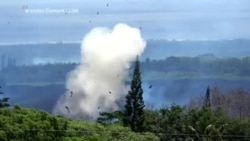ບ່ອນແຕກແຫ່ງໃໝ່ໄດ້ເປີດອອກ ໃນຂະນະທີ່ພູໄຟ ຄີໂລເວອາ (Kilauea) ໃນເກາະ
ໃຫຍ່ຫຼື ບິຄ ໄອແລນ (Big Island) ສືບຕໍ່ການລະເບີດ.
ນີ້ແມ່ນ ບ່ອນແຕກ ທີ 19 ທີ່ໄດ້ເປີດອອກ ໃນວັນຈັນວານນີ້ ໃນເຂດສວນລານີປູນາ
ແລະຂົງເຂດດັ່ງກ່າວ ແມ່ນໄດ້ທຳການຍົກຍ້າຍ ຜູ້ຄົນອອກໜີແລ້ວ. ເຈົ້າໜ້າທີ່ປົກ
ປ້ອງພົນລະເຮືອນ ໄດ້ເຕືອນກ່ຽວກັບການປ່ອຍແກສຂອງພູໄຟ ແລະການລະເບີດ
ທີ່ຍັງດຳເນີນຢູ່ຕໍ່ມາຢູ່ບ່ອນແຕກແຫ່ງໃໝ່ນີ້.
ການລະເບີດຢ່າງຕໍ່ເນື່ອງ ໄດ້ເລີ່ມຂຶ້ນໃນຕົ້ນເດືອນນີ້ ແລະໄດ້ທຳລາຍຕຶກອາຄານ
ຫຼາຍກວ່າ 40 ຫຼັງແລ້ວໃນເກາະນີ້. ເຖິງແມ່ນວ່າລາວາທີ່ໄຫຼອອກມານັ້ນ ໄດ້ແຂງຕົວ
ແລ້ວກໍຕາມ ແຕ່ຮອຍແຕກແຫ່ງໃໝ່ ແມ່ນປາກົດວ່າ ໄດ້ມີເພີ່ມຂຶ້ນຢູ່ເລື້ອຍໆ.
ນັກຊ່ຽວຊານກ່າວວ່າ ມັນຍັງສືບຕໍ່ເປັນໄພຂົ່ມຂູ່ ທີ່ວ່າລາວາ ອາດຈະໄຫຼລົງສູ່ສາຍນ້ຳ.
ຖ້າ ຫາກເປັນເຊັ່ນນັ້ນແລ້ວ ນ້ຳອາດຈະໄຫຼເຂົ້າໃສ່ລາວາທີ່ຮ້ອນຢູ່ ແລະອາດເຮັດໃຫ້ມີ
ອາຍນ້ຳພໍ ທີ່ຈະສາມາດເຮັດໃຫ້ມີການລະເບີດຢູ່ທີ່ຈອມພູໂດຍການສົ່ງຂີ້ເທົ່າແລະເສດຫີນລົງມາ. ຫີນ “ທີ່ໃຫຍ່ຊ່ຳງົວ” ອາດຈະຖືກສົ່ງລົງມາໄກເຖິງ 800 ແມັດຈາກບ່ອນທີ່
ພູເຂົາໄຟລະເບີດນັ້ນ ອີງຕາມນັກຊ່ຽວຊານຄົນນຶ່ງ ທີ່ໄດ້ກ່າວຕໍ່ສື່ມວນຊົນໃນທ້ອງຖິ່ນ.
ພູໄຟ ຄີໂລເວອາ (Kilauea) ໄດ້ລະເບີດເປັນຄັ້ງເປັນຄາວ ໃນຮອບ 3 ທົດສະວັດທີ່ຜ່ານ
ມານີ້. ລາວາ ໄດ້ໄຫຼເປັນທາງລົງມາຈາກພູໄຟ, ຊຶ່ງ 1 ໃນ 5 ຂອງເສັ້ນທາງດັ່ງກ່າວ ໄດ້ຖົມເອົາເຂດນຶ່ງ ທີ່ກວ້າງປະມານ 125 ກິໂລແມັດມົນທົນ ອີງຕາມອົງການສຳຫຼວດທໍລະນີວິທະຍາຂອງສະຫະລັດ.
ພວກນັກວິທະຍາສາດ ກ່າວວ່າ ພວກເຂົາເຈົ້າບໍ່ສາມາດທຳນາຍໄດ້ວ່າ ອີກດົນປານໃດ
ການລະເບີດໃນປັດຈຸບັນນີ້ ຈະດຳເນີນຕໍ່ໄປ.
A new fissure has opened as the Kilauea volcano on Hawaii's Big Island continues to erupt.
A 19th fissure opened Monday in the Lanipuna Gardens subdivision, an area that has already been evacuated. Civil defense officials warned of volcanic gas emissions and active eruptions with the new fissure.
The explosive series of eruptions began earlier this month, and have destroyed more than 40 structures on the island. Even as the lava flows harden, new fissures keep emerging.
Experts say there is a continuing threat that the lava could drop below the water table. If that happens, water could pour onto the hot lava and produce enough steam to explode from the summit in a shower of ash and debris. Rocks "the size of cows" could be hurled as far as 800 meters from the site of the blast, according to one expert who spoke to local media.
The Kilauea volcano has been erupting periodically for more than three decades. Lava flows from the volcano, one of five on the island, have buried an area about 125 square kilometers, according to the U.S. Geological Survey.
Scientists say they cannot predict how long the current eruption will last.





